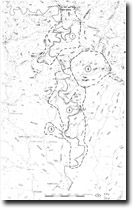8322-6 Sandy Creek
|
This information has been developed from the publications:
|
Location: | 375362 - 330350. From the Sandy Creek Road Crossing to the junction of Sandy Creek with the Mitchell River. |  8322 4-7 |
Abstract: | Exposures of Kilgower and Roaring Mag Member of the Devonian Tabberabbera Formation. | |
Access: | Sandy Creek Track. | |
Ownership: | Crown land. | |
Geology: | Sandy Creek and tributaries provide exposures of the upper members of Wentworth Group. This group has been sub-divided into two formations, the Wild Horse Formations and the Tabberabbera Formation. Within the latter formation, three members have been recognised, the Dead Bull Member, the Kilgower Member and the Roaring Mag Member. The latter two members are represented in Sandy Creek and the tributaries of Gorge Creek and Roaring Mag Creek. Exposures of these members are poor apart from the watercourses of the creeks. Major Fossil localities (F), are show in the figure below. The Kilgower Member unconformably overlies Ordovician sandstones, siltstones and cherty slates, the contact occurring approximately one kilometre down Sandy Creek from the crossing of Sandy Creek Road. The basal sandstone of the Kilgower Member is exposed in this area and is distinctive as it contains a noticeable proportion of rock fragments. This unit gives way to finely laminated, poorly cemented and slightly micaceous sandstones and then to fine silt sandstones. These sediments dip to the west at between 40 to 50 degrees for a short distance downstream from the Ordovician - Devonian boundary. However, in the vicinity of Warrigal Bend dips increase to between 70 and 80 degrees as a result of a small flexure. A distinct facies change also occurs at this locality and the lower sandstones are replaced by highly calcareous siltstones, claystones and occasional thin beds of impure limestone. Downstream from Warrigal Bend, the fine grained calcareous sediments are replaced by a thick sequence of coarse grained, poorly sorted quartz sandstones. These latter sediments represent the upper units of the Kilgower Member and are succeeded by a wide variety of fine grained detrital sediments comprising the Roaring Mag Member. The contact between the members is marked by a belt of contortion exposed in a river cliff (A) in Sandy Creek, and also in the bed of Gorge Creek (B). The Roaring Mag Member, downstream from the contact has been folded into four major anticlinal and synclinal axes and this is contrasted with the tight, but simple syncline occurring in the Wentworth Group north of Tabberabbera. The Roaring Mag Member is best exposed in Roaring Mag Creek where it consists of fossiliferous claystones, siltstones, fine sandstones and thin beds of argillaceous limestone. Small crystals of pyrite are commonly dessimated throughout the rocks. The Kilgower Member is rich in brachiopods and molluscs, includes some corals and a single species of stromatoporoid. The knowledge of the Lower and Middle Devonian brachiopods and molluscs elsewhere in Victoria is incomplete, the coral fauna is different from faunas described elsewhere, while the stromatoporoid species is not recorded elsewhere in Eastern Australia. Consequently, definitive age determination of this member has not been possible, although the fossil association suggests a broad Emsian age. Seventeen invertebrate species have been collected from the Roaring Mag Member and these indicate an early middle-Devonian age for this member, although the great thickness of strata involved suggests that the possibility of a Givetian age for some of this member cannot be ruled out. The Wentworth Group has been intruded by a series of dykes; quartz diorite, hornblende porphyrite and quartz feldspar porphyrite dykes are the most prominent and these are represented in Sandy Creek, near the junction with the Mitchell River and near the junction of Gorge Creek. The dyke swam is pre-Upper Devonian in age and the lineation of the swarm parallel to the fold axis of the Wentworth Group indicates that intrusion was associated with the folding of these sediments. Rhyolitic and basic dykes are also found in Sandy Creek. | |
Significance: | State. Representative sections displaying the lithology, of the upper members of the Tabberabbera Formation are exposed in Sandy Creek and its tributaries. | |
Management: | The best exposures occur in the stream channels and sections of cliffed or steep channel side slopes. Flooding of Sandy Creek through dam construction would obscure the exposures and destroy the significance of this site. Access is limited at present and any upgrading of access along the creek could potentially degrade the quality of the fossil bearing outcrops. | |
References: | Talent, M.M. 1963. 'The Devonian Brachiopods and Pelecypods of the Buchan Caves Limestone, Victoria', Proc. R. Soc. Vict., 68-70 :1-61. | |


